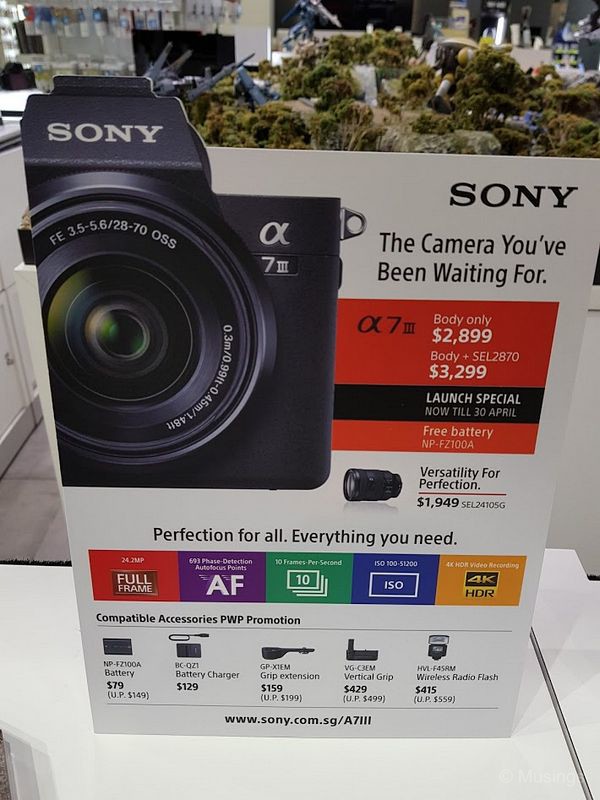It’s been about 8 years now since my move to the m4/3 standard – and starting April 2018, I’ll be moving again – and this time to the Sony Alpha FE system.
This decision to move to a full-frame system has long been in gestation. As recently as 3 years ago, I did think of moving from m4/3 to either Fujifilm or Sony – but decided not to at that point. For Fujifilm (yes I’m aware it’s not full-frame), I was giving up sensor-based stabilization and personal preferences of how I like to handle my cameras in return for a slightly larger imaging sensor. Not a good set of trade-offs. The general feeling is that image-quality wise, the jump from a m4/3-sized sensor to a cropped sensor – like that used in the Fujifilm X bodies – is relatively minor. For Sony, the early A7 models were loud, horrendously expensive, relatively lower-spec and less featured than the best m4/3 cameras, comparatively large lenses – but in return for a much larger sensor with better dynamic range potential and noise-control. A more favorable set of trade-offs, but I couldn’t get past the noisy and slow A7 models of that point. And both Fujifilm and Sony lenses were generally larger and pricier too. So, that year, I ended up deciding to stay with m4/3, and added a few great pieces of equipment: the E-M1, and the pair of Olympus Pro lenses – the 12-40mm and 40-150mm f2.8s.
The situation now today in 2018 is quite different. Despite insisting that the design of its cameras would make it impossible to include sensor-based stabilization, Fujifilm has finally done this impossible bit with its newest flagship – the X-H1. And their lens range has further improved over the last few years. Sony was also happily swimming along with a rapidly expanding lens family – helped in no small part by support from third party lens manufacturers, e.g. Samyang, Venus Optics Laowa, Rokinon. But the just released A7 Mark III (A73) is a game changer: it brought modern and advanced imaging features to a previously unheard of bargain price. Up till this point, a full-frame full-featured mirrorless camera simply did not exist for under USD2,000. Simply put, for the feature list crammed into the A73, one would have expected Sony to price it at twice what it’s actually asking now.
And credit too to Sony for its very clever marketing at launch. As though branding this near top-of-the-line camera as an ‘entry’ model wasn’t their very cheeky way of telling CaNikon who’s the real innovator and market leader and simultaneously entrenching their current monopoly in full-frame mirrorless space, Sony also invited a few dozen YouTube reviewers to Las Vegas for its 26 Feb announcement event a month ago. Ever since that event and following the publication of the YouTube videos reporting the reviewers’ experiences of the new A73, enthusiast forums have been on fire talking about the new model, replete with persons who’re now abandoning their existing systems to join the Sony full-frame camp with the A73. Despite the other camera system loyalist protestations that this is really normal behavior whenever a hyped-camera is announced and that there’s nothing to see here, I honestly don’t recall ever seeing this much interest in a single camera announcement before. Certainly not in the last 5 years. The last game changer in my books when Olympus announced their E-M5, and even that didn’t in my recollection generate this much excitement!
The A73 has even already landed into some users’ hands in the regional Asian market, including Singapore, making some of the American-enthusiasts upset/annoyed/green with envy. To be fair, the stock of initial releases to local stores here was very limited – just five units were available in each store, or so I heard. For the most part, only the persons who’d placed pre-orders could get their hands on one in the first release on 22 Mar. The main release will be on 17 April onwards here, and – as I hear it too – many of the camera stores here are receiving a lot of interest in this next wave of pre-orders too. As it turns out, the A73 is price-controlled, so it wouldn’t have made any difference whether I pre-ordered from the official Sony Store, or from one of my regular camera store haunts elsewhere. So over the holiday weekend, I joined the second pre-order at Sony Store-Nex. That I’d received a bonus infusion for work done last year played no small part to my decision haha!
All said and still, unless the person prints money for a living, changing camera systems are likely the most major events for any enthusiast. And the longer you’ve invested into an existing system, the more expensive changing systems get – since electronics, including camera and optical equipment, normally depreciate in value over time. There’s also the period of transition that while you’re acquiring new lenses, your lens arsenal will have gaps – making it hard to capture moments with the styles and focal lengths you’re normally used to. Happily for myself, I’m not a professional photographer and have no aspirations to be one. My expectations of optical greatness is considerably low compared to other enthusiasts. So I find it easier to balance between needs vs expenditure when deciding new lenses when I change camera systems. The next post will look at my thought processes on finding equivalent lenses in the Sony FE system.

So, exciting times ahead. Continued in the next post!
The series of Sony A7 III posts:
Sony A7 III – Part 1 – Journey to Alpha-verse
Sony A7 III – Part 2 – Lens Sense Making
Sony A7 III – Part 3 – Early Impressions
Recent comments